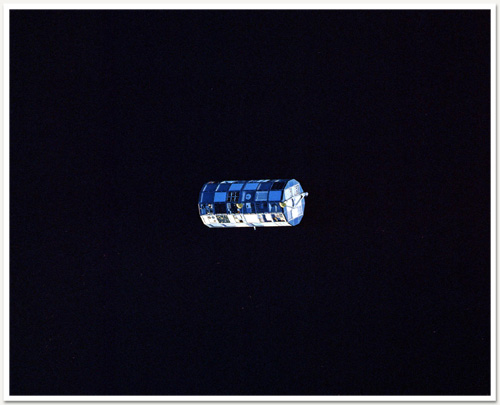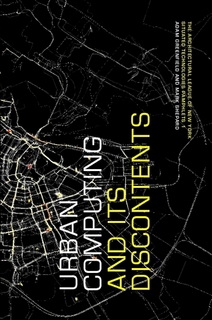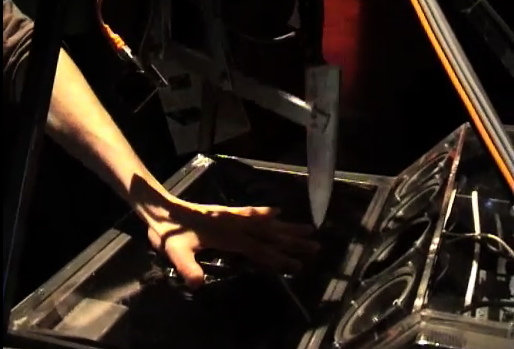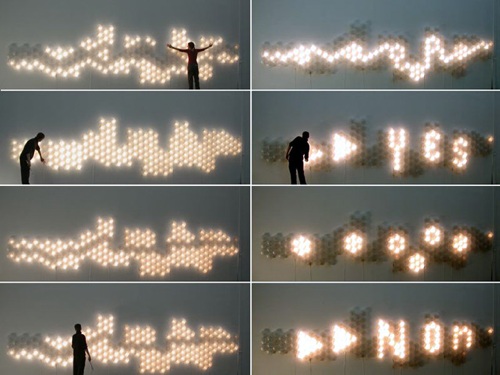Things tagged tech:
Long Duration Love Affair
JMorrison at the nonist:
That cylindrical object you see pictured above is a roughly school-bus sized structure which was deployed into space in 1984. It orbited the Earth for five and a half years with nothing expected of it other than to float there, getting battered about by whatever the great black yonder saw fit to throw at it. You see, every inch of its outside surface was covered with Science. 57 separate experiments, mounted in 86 trays, involving the participation of “more than 200 principal investigators from 33 private companies, 21 universities, seven NASA centers, nine Department of Defense laboratories and eight foreign countries.” Its purpose was to study the effects of space on a multitude of materials. Its name is the Long Duration Exposure Facility (LDEF) and I am deeply in love with it.
Via cityofsound.
Digital technology is transforming photojournalism
Andrew Blum in Hard Focus (Print Mag) reproduced on his site:
Gone are the days when photojournalists lugged a chunky Rolleiflex TLR into the field and sent film home on planes. Digital technology has streamlined the process—while adding a few of its own complications. To find out more about how technology is changing photojournalism, I tracked down a few of the conflict photographers who travel around the world from hot spot to hot spot
Via cityofsound.
Bruce Sterling: State of the World, 2008
Bruce does his annual "state of the world" conversation with Jon Lebkowsky and others on The WELL.
Urban Computing and its Discontents
Since the late 1980s, computer scientists and engineers have been researching ways of embedding computational intelligence into the built environment. Looking beyond the model of personal computing, which placed the computer in the foreground of our attention, “ubiquitous” computing takes into account the social dimension of human environments and allows computers themselves to vanish into the background. No longer solely virtual, human interaction with and through computers becomes socially integrated and spatially contingent, as everyday objects and spaces are linked through networked computing.
Conversation between Adam Greenfield and Mark Shepard.
Go read, this is important.
Via Bruce Sterling at Beyond the Beyond.
The Ken Kutaragi Crazy Game Exec Quote Award
Posted by Game|Life to Wired News.
With PlayStation dad Ken Kutaragi taking home the Lifetime Achievement Award at DICE this year, there’s one achievement of his that isn’t in the list of honors: His ability to come up with amazingly insane sound bites. Just a few:
(On PS3’s price) “It’s probably too cheap.”
(On PS3’s price) “We want consumers to think to themselves ‘I will work more hours to buy one.’”
(On PS2’s tech) “Same interface. Same concept. Starting from next year, you can jack into The Matrix!”
constraint city
A chest strap (corset) with high torque servo motors and a WIFI-enabled game-console are worn as fetish object. The higher the wireless signal strength of close encrypted networks, the tighter the corset becomes. Closed network points improve the pleasurable play of tight lacing the performer‘s bustier. Thus, constituting the aether as a space of possible pregnancy, filled with potential access-points to the networks of communication. Everyday walks between home, work and leisure are recompiled into a schizogeographic pain-map which is fetched from GoogleMaps servers with automated scripts. By wearing the straight-jacket, the artist not only writes, but is at once also able to read the city code.
Via MAKE: Blog.
VectorMagic
Posted by John Gruber to Daring Fireball.
Free online web app, converts bitmap images into vector art, and does a surprisingly good job of it. (Via Gus Mueller.)
KNIFE.HAND.CHOP.BOT
Via Bruce Sterling at Beyond the Beyond.
Electric contacts are mounted on the support block of the Machine, where the hand is situated. These contacts are activated as soon as the first "nervous sweat" appears that turns the skin into a conductor. Subsequently the computer becomes disturbed by the electric current that is now transmitted via the skin.
This has two effects: on the one hand, sounds are generated by the closure of the contacts (circuit bending) that can either be interpreted as warning or act as an additional source of stress. On the other hand, they can have an effect on the position of the knife which is controlled by the computer and thereby hurt the potential perpetrator of the disturbance.
By 5voltcore
Binary marble adding machine
Via MAKE: Blog.
Matthias Wandel has the coolest project ever, a binary marble computer.
Assurance
Schneier on the recent release of the California security review of electronic voting machines, and what CA is doing about the across the board failures:
California Secretary of State Debra Bowen has conditionally recertified the machines for use, as long as the makers fix the discovered vulnerabilities and adhere to a lengthy list of security requirements designed to limit future security breaches and failures. [ …] While this is a good effort, it has security completely backward. It begins with a presumption of security. […] Insecurity is the norm. If any system – whether a voting machine, operating system, database, badge-entry system, RFID passport system, etc. – is ever built completely vulnerability-free, it’ll be the first time in the history of mankind. It’s not a good bet.
So, what to do? Assurance:
Several years ago, former National Security Agency technical director Brian Snow began talking about the concept of “assurance” in security. Snow, who spent 35 years at the NSA building systems at security levels far higher than anything the commercial world deals with, told audiences that the agency couldn’t use modern commercial systems with their backward security thinking. Assurance was his antidote.
The Wit and Wisdom of the 21st-Century Printing and Packaging Biz
Posted by Bruce Sterling to Beyond the Beyond.
Overheard at the "INTELLIGENT PRINTING" conference, Oct 2006
"We're in the business of putting goo on a substrate."
"We need a taxonomy for 'printing-that-is-no-longer-printing.'"
"Your mega-customer, the anchor tenant in the mall of your dreams"
"It's the business of killing trees and putting chemicals on them."
"Baseball cards that suck in energy and run e-ink animated displays"
"They're not hiding, they're just selective."
"We help companies put together arguments and stories to win that venture money."
"Those Austrian farm-boys didn't know that ink-plants were supposed to be messy, so that was one of the cleanest plants they ever had."
"Electronic cardboard blurs the line between printed objects and the virtual world."
"The supply chain is a network of atoms."
"Six trillion RFID tag is four orders of magnitude bigger than any electronic item ever made."
"You can't take on the Silicon Gorilla face to face."
"Fluidic Self-Assembly Machines aren't 'printing' -- they're the competition."
Read more at Beyond the Beyond.
A Wristwatch for Your Handset
Posted to Wired News.
Fossil and Sony Ericsson are developing timepieces that tell you who's calling your cell phone.
In Gear Factor.
Read more at Wired News
Dynamic-Language IDEs
Posted by Tim Bray to ongoing.
Read more at ongoing.
Light Brix - Touch sensitive light graffiti
Posted by philliptorrone to MAKE: Blog.
Helen Evans and Heiko Hansen made a modular light system for architecture, which reacts to the electromagnetic fields generated by touch. Link.
Via MAKE: Blog.
That Reminds Me: I Gotta Drive to San Francisco Today
Posted by Bruce Sterling to Beyond the Beyond.
FERAL CITIES
Richard J. Norton
Naval War College Review, Autumn 2003, Vol. LVI, No. 4
https://www.hsdl.org/?abstract&did=733339
FERAL CITIES
Richard J. Norton
Naval War College Review, Autumn 2003, Vol. LVI, No. 4
Imagine a great metropolis covering hundreds of square miles. Once a vital component in a national economy, this sprawling urban environment is now a vast collection of blighted buildings, an immense petri dish of both ancient and new diseases, a territory where the rule of law has long been replaced by near anarchy in which the only security available is that which is attained through brute power.1
Such cities have been routinely imagined in apocalyptic movies and in certain science-fiction genres, (((yo!))) where they are often portrayed as gigantic versions of T. S. Eliot’s Rat’s Alley.2 Yet this city would still be globally connected. It would possess at least a modicum of commercial linkages, and some of its inhabitants
would have access to the world’s most modern communication and computing technologies. It would, in effect, be a feral city.
Admittedly, the very term “feral city” is both provocative and
controversial.
Visit Beyond the Beyond for Bruce's funny inline comments.




